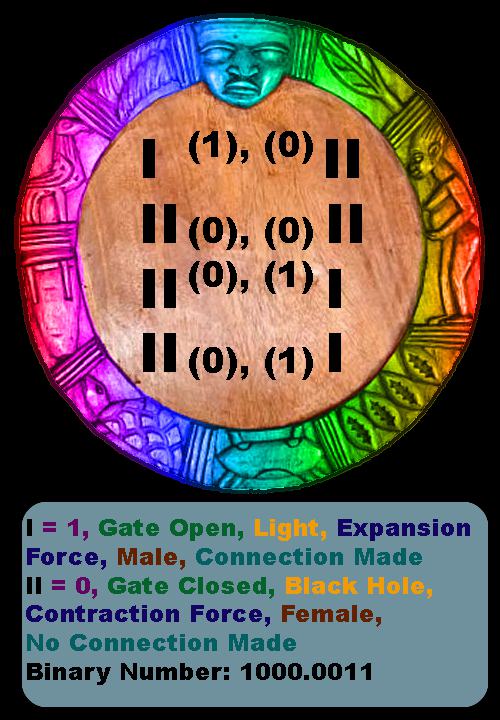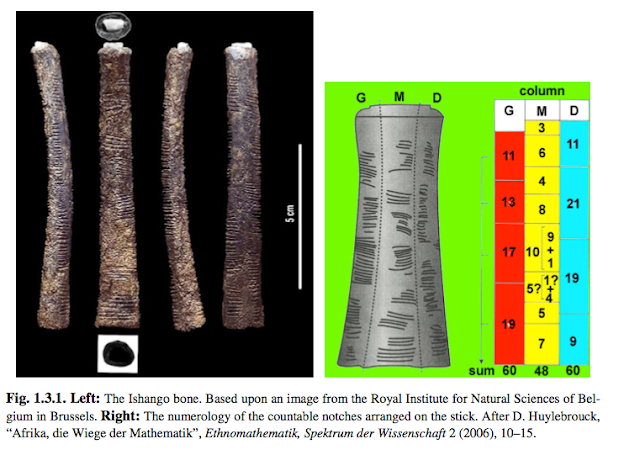Ancient Mathematics, Ifa, Chinese, Sikidy and Geomancy Divination Systems Part 2
Sacred Geometry is a complex and sophisticated science that requires objective study and subjective meditation. The most crucial shape in understanding possession by Ela is the tetrahedron. If you turn a sphere into a three-sided pyramid with the base at 19.5 degrees below the equator and the apex at the North Pole, the result should be a tetrahedron.
 |
| Illustration of Odu Portal Points |
To complete Odu patterns, a Babalawo needed two tetrahedrons, with the apex of the top one on the North Pole and the bottom one on the South Pole, generating eight portal points. The Babalawos will then employ the pure philosophy of Ifa to decipher the portal points meaning.
To open portals, place the second three-sided pyramid inside a sphere with the base at 19.5 degrees above the equator and the apex at the South Pole. In Ifa, these portals or Odu means womb. Each point where the pyramid makes contact with the circumference of the sphere is a portal for Odu, which is the point of entry for light from the Invisible realm into the Visible Realm (Orun and Aye, heaven and earth).
 |
| Illustration of Yoruba Multiplication Technique |
In the process of divination, Ifa priests employ the use of a complex system of signs/codes. These codes are widely studied, and to foster in-depth understanding, researchers have considered them vis-a-vis their relationship with other fields of study, for instance, carried out code characteristics of Ifa signatures akin to binary operation in computer science.
 |
| Amulu |
The need for further study of these codes is supported by those who opined that despite several studies devoted to it in recent times, Ifa remains an intractable subject for many, a bewildering cellar of ancient wisdom, and this is not only due to the complex web of fetish associated with it but also to the paraphernalia and elaborate divination procedure incidental to life.
According to Ifa divination mythology, the generation of the signature codes occurs during divination. These codes, in conjunction with the entire Ifa divination system, possesses a large spectrum of properties that demands exploration still, only a few of these properties have, and it led to a lack of basic understanding of the working of the divination system and a high level of misconception about Ifa. Ifa thus becomes unattractive, considered obsolete and evil in some parts of African society and beyond.
Chinese Divination System
In the middle of Figure 1 is the symbol of Tàijí, "the Extreme Ultimate". Tàijí is the unity from which everything originates: it splits into duality, the duality splits in four, and the four splits in eight.
 |
| Figure 1 |
The Taoist universe consists of an infinity of binary data - yins and yangs constantly turning into each other. The only unchanging thing is the ultimate principle itself.
Trigram symbols are everywhere. The flag of South Korea contains four symmetrical three-bit binary numbers.
In the Feng Shui system (mega-fashionable in the West nowadays), you may even hang binary numbers on your walls because you believe in their magical power of modifying the energies inside the building.
Three bits is the smallest binary number that allows a "true RGB palette" (one bit for each red, green and blue component).
Incidentally, the Chinese trigrams are also traditionally associated with colours. The image below Figure 2 presents the six-bit binary combinations in two different arrangements: an eight-by-eight matrix (in ascending binary order) and a "xiantian"-ordered circle.
The figure was composed in the 11th century by Shào Yong, the famous philosopher and oracle who believed it was the original "xiantian" order in which the legendary emperor, Fú Xi, discovered the hexagrams millennia ago. Centuries later, the German philosopher G.W. Leibniz received a copy of this figure from Jesuit missionaries trying to convert Chinese people to Christianity.
 |
| Figure 2 |
It is basically an oracular handbook ("Give me a random number, and I'll tell you what lies ahead"). However, due to its highly-honoured status in Chinese culture, its "message" has been thoroughly examined during the millennia. The properties of the six-bit binary numbers are examined as whole entities (symmetry, yin/yang constitution, visual shape) and in small pieces (the properties of every sub-trigram and the properties of each bit separately).
In the Pythagorean numerology, natural numbers had mystical properties and even personalities, including similar numerology applied to binary combinations in ancient China. In the Yì Jing divination, each line of the result can be either static or changing (the resulting hexagram turning into some other hexagram).
 |
| Figure 3 |
It gives 4096 possible readings. A man named Chiao Kan actually wrote 4096 rhymed verses to describe every possible transition. After this, philosophers started to speculate about interchanging evolutions.
In the words of Shú Xi, if from the 12-line diagrams we continue generating undivided and divided lines, eventually we come to 24-line totalling 16,777,216 changes.
Taking 4,096 and multiplying it by itself also gives this sum. Expanding, we do not know where it ultimately ends.
Although we cannot see its usefulness, it is sufficient to show that the Way of Change is inexhaustible. No one was prolific in a lifetime enough to write out all the 16,777,216 second-order transitions.
However, what makes the six-bit code especially divine even for modern people is its application in the genetic code that describes the hardware of every living organism on this planet. (In fact, a "genetic byte" consists of three symbols from an alphabet of four, but the amount of information is exactly the same).
Rhind Papyrus
The Rhind Mathematical Papyrus is one of the best-known examples of ancient Egyptian mathematics. Alexander Henry Rhind, a Scottish antiquarian, purchased the Papyrus in 1858 AD in Luxor, Egypt, and named it after him. The awareness of the whereabouts of the Rhind Papyrus became known during illegal excavations in or near the Ramesseum.
 |
| Rhind Papyrus |
It dates to around 1550 BC.
Author: August Eisenlohr
Date: Second Intermediate Period of Egypt
Language(s): Egyptian (Hieratic)
Place of origin: Thebes
Moscow Mathematical Papyrus
 |
| Moscow Mathematical Papyrus |
The Moscow Mathematical Papyrus, also named the Golenishchev Mathematical Papyrus after its first non-Egyptian owner, Egyptologist Vladimir Golenishchev, is an ancient Egyptian mathematical papyrus containing several problems in arithmetic, geometry, and algebra.
Owner: Vladimir Golenishchev
Date: 13th dynasty, Second Intermediate Period of Egypt
Euclid
Euclid was an ancient Greek mathematician active as a geometer and logician. Credited with the accolade of the father of geometry, he is chiefly known for the Elements treatise, which established the foundations of geometry that largely dominated the field until the early 19th century.
Died: Alexandria, Egypt
Nationality: Greek
Influenced: Isaac Newton, Apollonius of Perga, and more
Inspired by Pythagoras, Thales of Miletus, Eudoxus of Cnidus, Hippocrates of Chios, and Theaetetus.
Sikidy Divination System of Madagascar
The study of divination and divination systems, particularly in so-called non-technological societies, presents unusual problems that challenge the core of rational and epistemic thought. Even so, the strenuous efforts in researching cultural genres, such as religion, magic, and myth, fall short of distinguishing constituent theoretical and ontological underpinnings of divinatory principles.
 |
| Sikidy's Order |
Ifa ((West Africa), Haiti, Cuba, Brazil, Caribbean, America)) the four-tablet system (South Africa) and Sikidy (Madagascar).
The first step in Sikidy is to arbitrate four columns of four bits (a four-by-four matrix).
The arbitration of one bit usually happens by grabbing a handful of seeds from a bag and removing two at a time until only one or two are left.
The remaining seeds must be placed properly on the Sikidy board.
Sikidy processing gives a new meaning to the concept of (random number seed).
The random columns ( Mother-Sikidy) are in the upper right corner.
The values of the columns from right to left, bottom to top, are 1010, 1001, 1011, and 0010.
The next thing to do is to form the Daughter-Sikidy by rotating and flipping the matrix.
 |
| Mother Sikidy |
The rightmost column of the Mother-Sikidy (bottom to top) becomes the top row (left to right) of the Daughter-Sikidy, and so forth.
Our Daughter-Sikidy (placed to the left of the Mother-Sikidy) is 0110, 1101, 0000, and 0111.
The rest is pure binary arithmetic.
The columns below the Mother-Sikidy and Daughter-Sikidy are formed by eXclusive-ORing each pair of columns: (1010 XOR 1001 = 0011), (1011 XOR 0010 = 1001), (0110 XOR 1101 = 1011) and (0000 XOR 0111 = 0111).
 |
| Daughter Sikidy |
As for the witnesses, it is (0011 XOR 1001 = 1010) and (1011 XOR 0111 = 1100). The Xor operator might look complicated but it is simple, for example, if you add (1010 to 1100 = (2110) we have to change the two, which is even to zero (0110) the binary number of the judge).
The image above shows an example of a completed Sikidy board.
This process is repeated to all the new lines until only one column is left (the bottom column, 0110 in the example).
We now have a complete Sikidy tableau, right to left (1010, 1001, 1011, 0010, 0110, 1101, 0000, and 0111) Mother Sikidy, Daughter Sikidy (0011, 1001, 1011 and 0111), Witnesses (1010 and 1100) and the Judge (0110), what is left is the interpretation.
 |
| Witnesses and the Judge |
Each of the sixteen Sikidy binary values has meaning, and each memory slot has a designated definition.
The Sikidy system was also adopted by Arabs (under the name of ilm Al-raml, the science of sand), and from Arabs, it even spread to Europe in the Middle Ages.
The end of part 2 and the final part will follow soon. Other Publications: Ancient Mathematics, Occultism and Astrology Part 1 King Solomon of Israel, Vs, Pharaoh, Amenemope The Immaculate Conception, an amazing deception Ifa, Sacred Geometry, Tetrahedron, Odu, Portals, Points The Baptismal Ceremony of The Gospel Of The Egyptians To learn more: A Study Finds that Yorubas Are Genetically 99.9% Igbo. There is a true story behind the Zombie legends. Ogham line alphabets, African Origin. This video presentation concentrated on prehistoric and ancient cultures in Africa and elsewhere. Namely, Gabon, Zambia, Nigeria, Mali, Chad, Congo, Khem, South Africa and Ethiopia. Gnostic Bible, The 34 Hidden Letters and Messages in Bismillah Al-Rahman Al-Rahim, Islamic Mystical Literature: Initiation and Prophecies of Djehuiti, Thoth, or Hermes and Atum





















